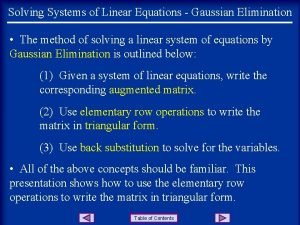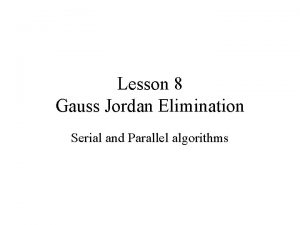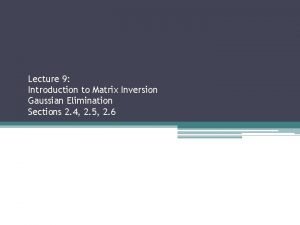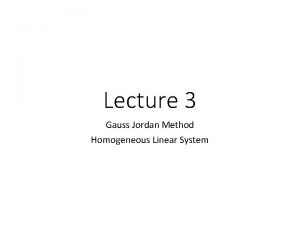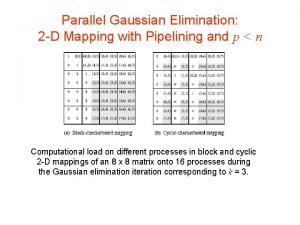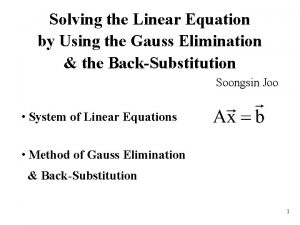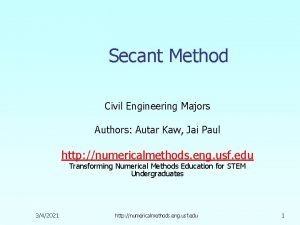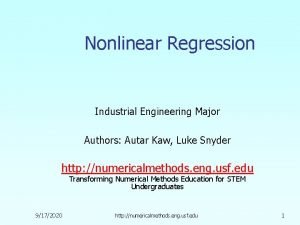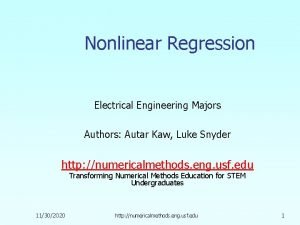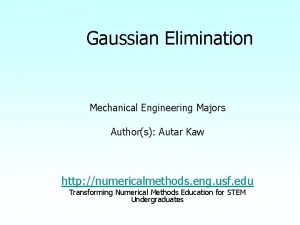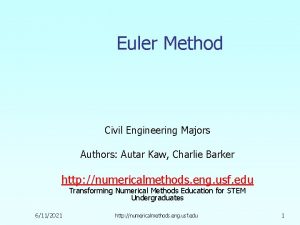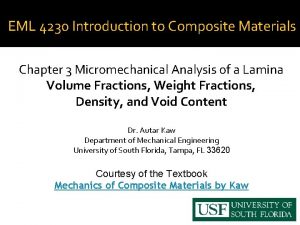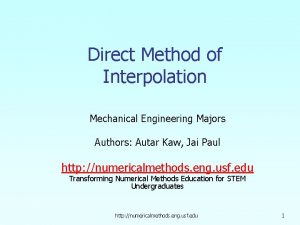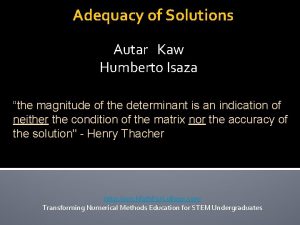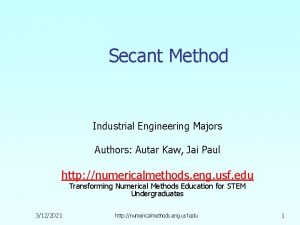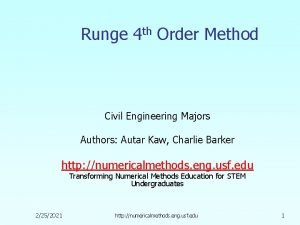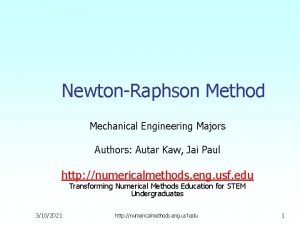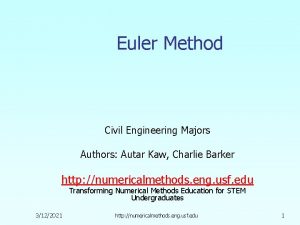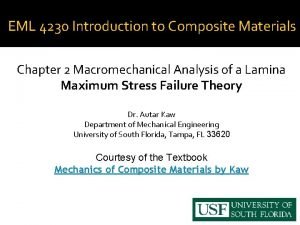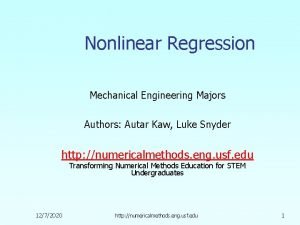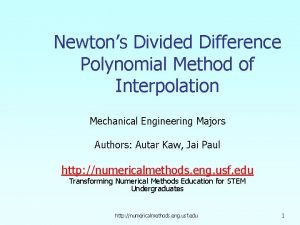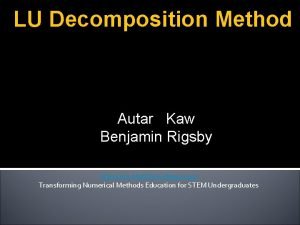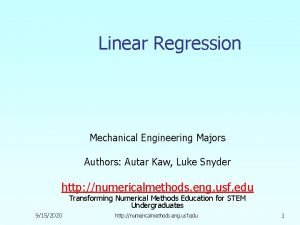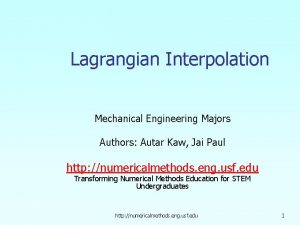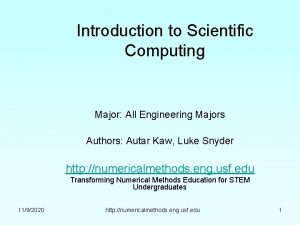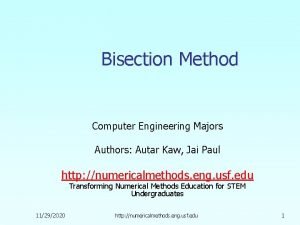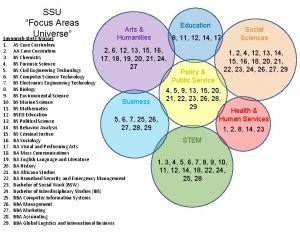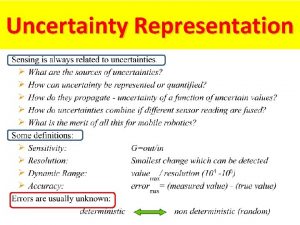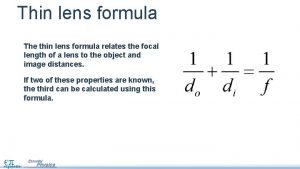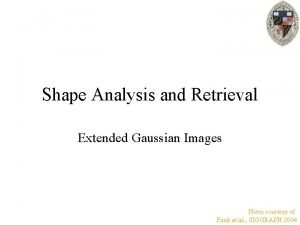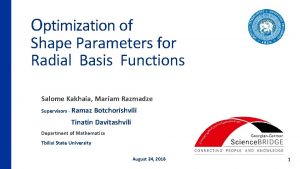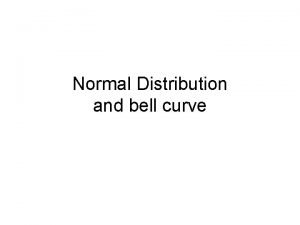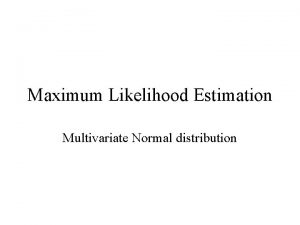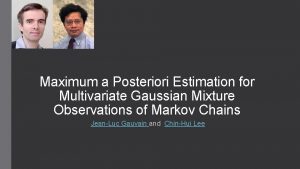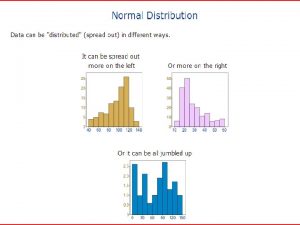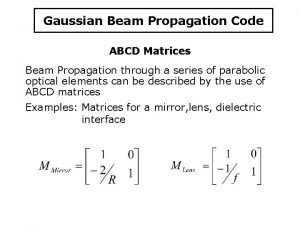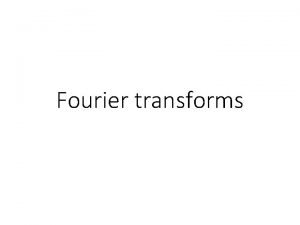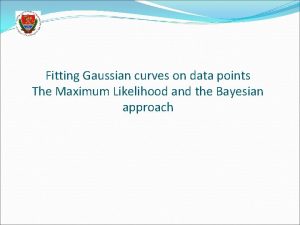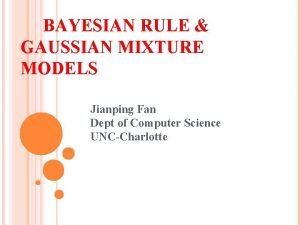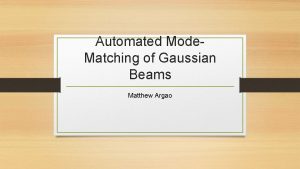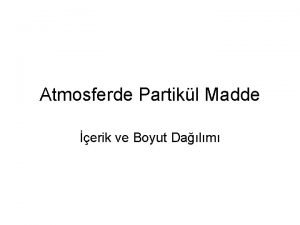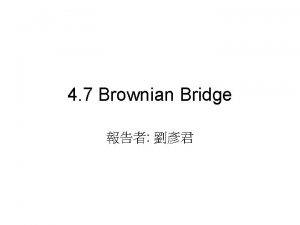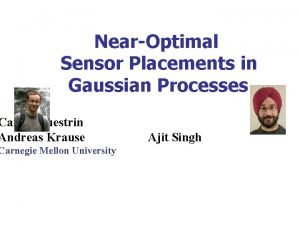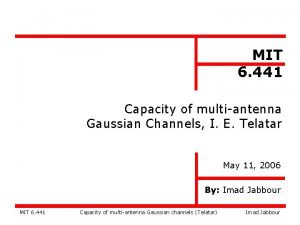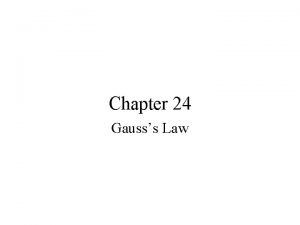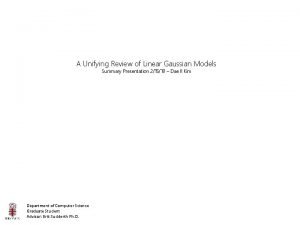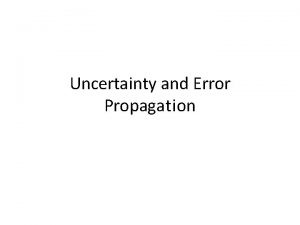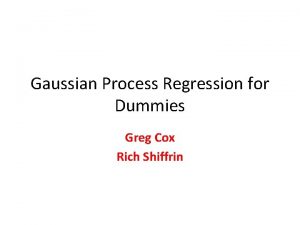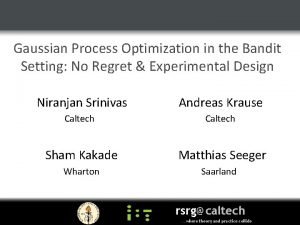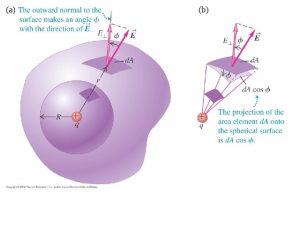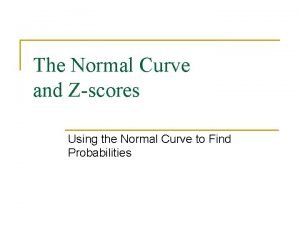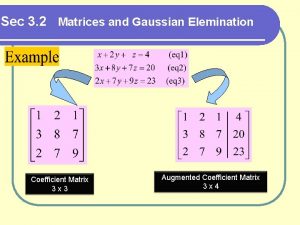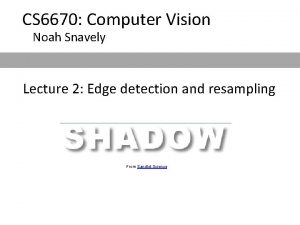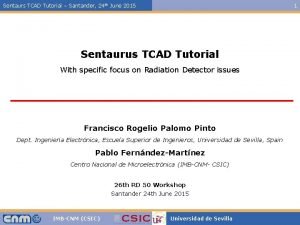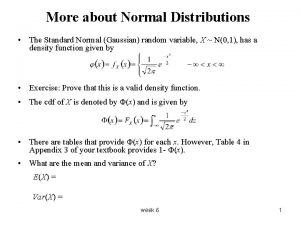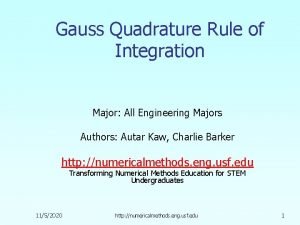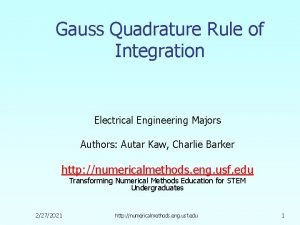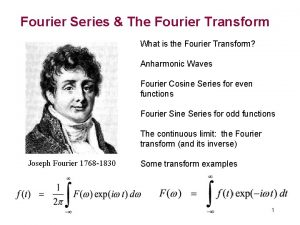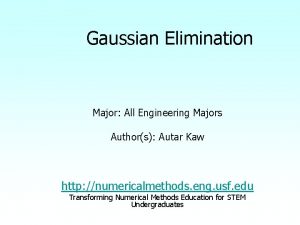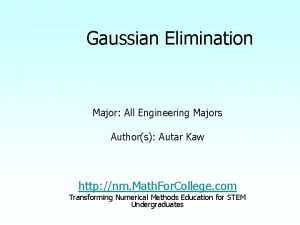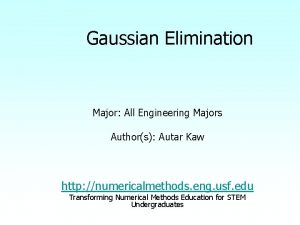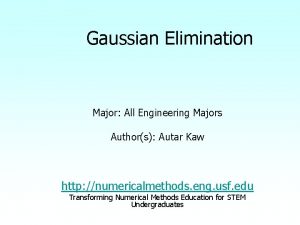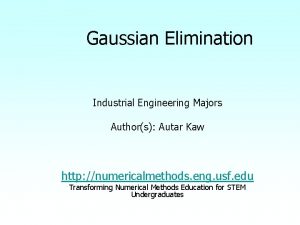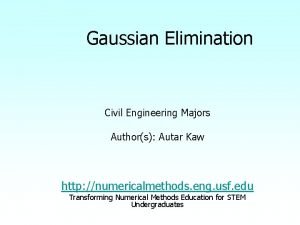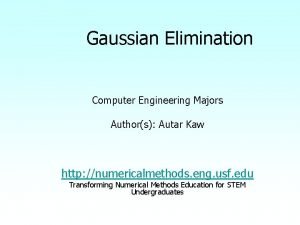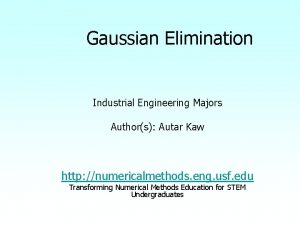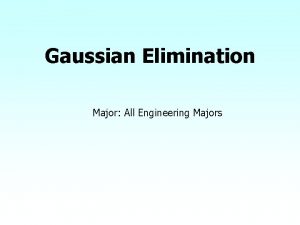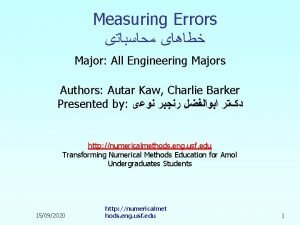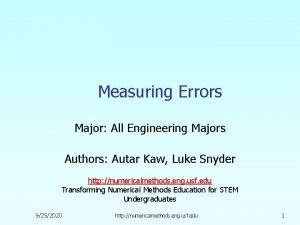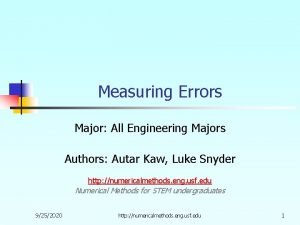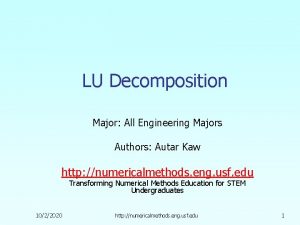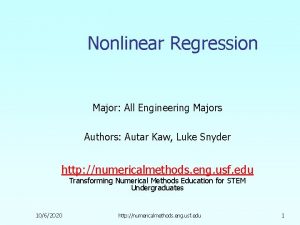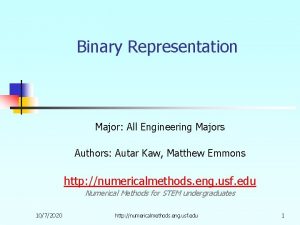Gaussian Elimination Major All Engineering Majors Authors Autar


![Naïve Gaussian Elimination A method to solve simultaneous linear equations of the form [A][X]=[C] Naïve Gaussian Elimination A method to solve simultaneous linear equations of the form [A][X]=[C]](https://slidetodoc.com/presentation_image_h/22d7fbb7b8ee9a48d8fbb3756639e6d2/image-3.jpg)













































































![Theorem of Determinants If a multiple of one row of [A]nxn is added or Theorem of Determinants If a multiple of one row of [A]nxn is added or](https://slidetodoc.com/presentation_image_h/22d7fbb7b8ee9a48d8fbb3756639e6d2/image-81.jpg)
![Theorem of Determinants The determinant of an upper triangular matrix [A]nxn is given by Theorem of Determinants The determinant of an upper triangular matrix [A]nxn is given by](https://slidetodoc.com/presentation_image_h/22d7fbb7b8ee9a48d8fbb3756639e6d2/image-82.jpg)
![Forward Elimination of a Square Matrix Using forward elimination to transform [A]nxn to an Forward Elimination of a Square Matrix Using forward elimination to transform [A]nxn to an](https://slidetodoc.com/presentation_image_h/22d7fbb7b8ee9a48d8fbb3756639e6d2/image-83.jpg)









- Slides: 92

Gaussian Elimination Major: All Engineering Majors Author(s): Autar Kaw http: //numericalmethods. eng. usf. edu Transforming Numerical Methods Education for STEM Undergraduates

Naïve Gauss Elimination http: //numericalmethods. eng. usf. edu
![Naïve Gaussian Elimination A method to solve simultaneous linear equations of the form AXC Naïve Gaussian Elimination A method to solve simultaneous linear equations of the form [A][X]=[C]](https://slidetodoc.com/presentation_image_h/22d7fbb7b8ee9a48d8fbb3756639e6d2/image-3.jpg)
Naïve Gaussian Elimination A method to solve simultaneous linear equations of the form [A][X]=[C] Two steps 1. Forward Elimination 2. Back Substitution

Forward Elimination The goal of forward elimination is to transform the coefficient matrix into an upper triangular matrix

Forward Elimination A set of n equations and n unknowns . . . (n-1) steps of forward elimination

Forward Elimination Step 1 For Equation 2, divide Equation 1 by multiply by. and

Forward Elimination Subtract the result from Equation 2. − _________________________ or

Forward Elimination Repeat this procedure for the remaining equations to reduce the set of equations as . . End of Step 1

Forward Elimination Step 2 Repeat the same procedure for the 3 rd term of Equation 3. . End of Step 2 . . .

Forward Elimination At the end of (n-1) Forward Elimination steps, the system of equations will look like . . . End of Step (n-1) . . .

Matrix Form at End of Forward Elimination

Back Substitution Solve each equation starting from the last equation Example of a system of 3 equations

Back Substitution Starting Eqns . . .

Back Substitution Start with the last equation because it has only one unknown

Back Substitution

Naïve Gauss Elimination Example http: //numericalmethods. eng. usf. edu

Example 1 The upward velocity of a rocket is given at three different times Table 1 Velocity vs. time data. Time, 5 8 12 Velocity, 106. 8 177. 2 279. 2 The velocity data is approximated by a polynomial as: Find the velocity at t=6 seconds.

Example 1 Cont. Assume Results in a matrix template of the form: Using data from Table 1, the matrix becomes:

Example 1 Cont. 1. Forward Elimination 2. Back Substitution

Forward Elimination

Number of Steps of Forward Elimination Number of steps of forward elimination is (n-1)=(3 -1)=2

Forward Elimination: Step 1 Divide Equation 1 by 25 and multiply it by 64, . Subtract the result from Equation 2 Substitute new equation for Equation 2 .

Forward Elimination: Step 1 (cont. ) Divide Equation 1 by 25 and multiply it by 144, . Subtract the result from Equation 3 Substitute new equation for Equation 3 .

Forward Elimination: Step 2 Divide Equation 2 by − 4. 8 and multiply it by − 16. 8, . Subtract the result from Equation 3 Substitute new equation for Equation 3

Back Substitution

Back Substitution Solving for a 3

Back Substitution (cont. ) Solving for a 2

Back Substitution (cont. ) Solving for a 1

Naïve Gaussian Elimination Solution

Example 1 Cont. Solution The solution vector is The polynomial that passes through the three data points is then:

THE END http: //numericalmethods. eng. usf. edu

Naïve Gauss Elimination Pitfalls http: //numericalmethods. eng. usf. edu

Pitfall#1. Division by zero

Is division by zero an issue here?

Is division by zero an issue here? YES Division by zero is a possibility at any step of forward elimination

Pitfall#2. Large Round-off Errors Exact Solution

Pitfall#2. Large Round-off Errors Solve it on a computer using 6 significant digits with chopping

Pitfall#2. Large Round-off Errors Solve it on a computer using 5 significant digits with chopping Is there a way to reduce the round off error?

Avoiding Pitfalls Increase the number of significant digits • Decreases round-off error • Does not avoid division by zero

Avoiding Pitfalls Gaussian Elimination with Partial Pivoting • Avoids division by zero • Reduces round off error

THE END http: //numericalmethods. eng. usf. edu

Gauss Elimination with Partial Pivoting http: //numericalmethods. eng. usf. edu

Pitfalls of Naïve Gauss Elimination • Possible division by zero • Large round-off errors

Avoiding Pitfalls Increase the number of significant digits • Decreases round-off error • Does not avoid division by zero

Avoiding Pitfalls Gaussian Elimination with Partial Pivoting • Avoids division by zero • Reduces round off error

What is Different About Partial Pivoting? At the beginning of the kth step of forward elimination, find the maximum of If the maximum of the values is in the p th row, then switch rows p and k.

Matrix Form at Beginning of 2 nd Step of Forward Elimination

Example (2 nd step of FE) Which two rows would you switch?

Example (2 nd step of FE) Switched Rows

Gaussian Elimination with Partial Pivoting A method to solve simultaneous linear equations of the form [A][X]=[C] Two steps 1. Forward Elimination 2. Back Substitution

Forward Elimination Same as naïve Gauss elimination method except that we switch rows before each of the (n-1) steps of forward elimination.

Example: Matrix Form at Beginning of 2 nd Step of Forward Elimination

Matrix Form at End of Forward Elimination

Back Substitution Starting Eqns . . .

Back Substitution

THE END http: //numericalmethods. eng. usf. edu

Gauss Elimination with Partial Pivoting Example http: //numericalmethods. eng. usf. edu

Example 2 Solve the following set of equations by Gaussian elimination with partial pivoting

Example 2 Cont. 1. Forward Elimination 2. Back Substitution

Forward Elimination

Number of Steps of Forward Elimination Number of steps of forward elimination is (n -1)=(3 -1)=2

Forward Elimination: Step 1 • Examine absolute values of first column, first row and below. • Largest absolute value is 144 and exists in row 3. • Switch row 1 and row 3.

Forward Elimination: Step 1 (cont. ) Divide Equation 1 by 144 and multiply it by 64, . Subtract the result from Equation 2 Substitute new equation for Equation 2 .

Forward Elimination: Step 1 (cont. ) Divide Equation 1 by 144 and multiply it by 25, . Subtract the result from Equation 3 Substitute new equation for Equation 3 .

Forward Elimination: Step 2 • Examine absolute values of second column, second row and below. • Largest absolute value is 2. 917 and exists in row 3. • Switch row 2 and row 3.

Forward Elimination: Step 2 (cont. ) Divide Equation 2 by 2. 917 and multiply it by 2. 667, . Subtract the result from Equation 3 Substitute new equation for Equation 3

Back Substitution

Back Substitution Solving for a 3

Back Substitution (cont. ) Solving for a 2

Back Substitution (cont. ) Solving for a 1

Gaussian Elimination with Partial Pivoting Solution

Gauss Elimination with Partial Pivoting Another Example http: //numericalmethods. eng. usf. edu

Partial Pivoting: Example Consider the system of equations In matrix form = Solve using Gaussian Elimination with Partial Pivoting using five significant digits with chopping

Partial Pivoting: Example Forward Elimination: Step 1 Examining the values of the first column |10|, |-3|, and |5| or 10, 3, and 5 The largest absolute value is 10, which means, to follow the rules of Partial Pivoting, we switch row 1 with row 1. Performing Forward Elimination

Partial Pivoting: Example Forward Elimination: Step 2 Examining the values of the first column |-0. 001| and |2. 5| or 0. 0001 and 2. 5 The largest absolute value is 2. 5, so row 2 is switched with row 3 Performing the row swap

Partial Pivoting: Example Forward Elimination: Step 2 Performing the Forward Elimination results in:

Partial Pivoting: Example Back Substitution Solving the equations through back substitution

Partial Pivoting: Example Compare the calculated and exact solution The fact that they are equal is coincidence, but it does illustrate the advantage of Partial Pivoting

THE END http: //numericalmethods. eng. usf. edu

Determinant of a Square Matrix Using Naïve Gauss Elimination Example http: //numericalmethods. eng. usf. edu
![Theorem of Determinants If a multiple of one row of Anxn is added or Theorem of Determinants If a multiple of one row of [A]nxn is added or](https://slidetodoc.com/presentation_image_h/22d7fbb7b8ee9a48d8fbb3756639e6d2/image-81.jpg)
Theorem of Determinants If a multiple of one row of [A]nxn is added or subtracted to another row of [A]nxn to result in [B]nxn then det(A)=det(B)
![Theorem of Determinants The determinant of an upper triangular matrix Anxn is given by Theorem of Determinants The determinant of an upper triangular matrix [A]nxn is given by](https://slidetodoc.com/presentation_image_h/22d7fbb7b8ee9a48d8fbb3756639e6d2/image-82.jpg)
Theorem of Determinants The determinant of an upper triangular matrix [A]nxn is given by
![Forward Elimination of a Square Matrix Using forward elimination to transform Anxn to an Forward Elimination of a Square Matrix Using forward elimination to transform [A]nxn to an](https://slidetodoc.com/presentation_image_h/22d7fbb7b8ee9a48d8fbb3756639e6d2/image-83.jpg)
Forward Elimination of a Square Matrix Using forward elimination to transform [A]nxn to an upper triangular matrix, [U]nxn.

Example Using naïve Gaussian elimination find the determinant of the following square matrix.

Forward Elimination

Forward Elimination: Step 1 Divide Equation 1 by 25 and multiply it by 64, . Subtract the result from Equation 2 Substitute new equation for Equation 2 .

Forward Elimination: Step 1 (cont. ) Divide Equation 1 by 25 and multiply it by 144, . Subtract the result from Equation 3 Substitute new equation for Equation 3 .

Forward Elimination: Step 2 Divide Equation 2 by − 4. 8 and multiply it by − 16. 8, . . Subtract the result from Equation 3 Substitute new equation for Equation 3

Finding the Determinant After forward elimination .

Summary -Forward Elimination -Back Substitution -Pitfalls -Improvements -Partial Pivoting -Determinant of a Matrix

Additional Resources For all resources on this topic such as digital audiovisual lectures, primers, textbook chapters, multiple-choice tests, worksheets in MATLAB, MATHEMATICA, Math. Cad and MAPLE, blogs, related physical problems, please visit http: //numericalmethods. eng. usf. edu/topics/gaussian_elim ination. html

THE END http: //numericalmethods. eng. usf. edu
 Gauss jordan matrix
Gauss jordan matrix Gaussova eliminacija
Gaussova eliminacija Gauss jordan method
Gauss jordan method Matrix inverse gaussian elimination
Matrix inverse gaussian elimination Non trivial solution
Non trivial solution Naive gaussian elimination
Naive gaussian elimination Parallel gaussian elimination
Parallel gaussian elimination Gaussian elimination
Gaussian elimination Autar kaw
Autar kaw Autar kaw
Autar kaw Autar kaw
Autar kaw Secant engineering
Secant engineering Autar kaw
Autar kaw Autar kaw
Autar kaw Autar kaw
Autar kaw Autar kaw
Autar kaw Autar kaw
Autar kaw Autar kaw
Autar kaw Autar kaw
Autar kaw Autar kaw
Autar kaw Autar kaw
Autar kaw Autar kaw
Autar kaw Autar kaw
Autar kaw Autar kaw
Autar kaw Autar kaw
Autar kaw Autar kaw
Autar kaw Autar kaw
Autar kaw Lu decomposition method
Lu decomposition method Autar kaw
Autar kaw Autar kaw
Autar kaw Autar kaw
Autar kaw Autar kaw
Autar kaw Tem 4
Tem 4 Base details tone
Base details tone German university jordan
German university jordan Ssu majors
Ssu majors Uwlax majors
Uwlax majors Texas state psychology
Texas state psychology Uwb majors
Uwb majors Ung sat
Ung sat Websmart smccd canvas
Websmart smccd canvas Wku minors
Wku minors Golden palace
Golden palace Elimination substitution engineering administrative ppe
Elimination substitution engineering administrative ppe Name three lines
Name three lines Major engineering problems in urea production
Major engineering problems in urea production Gaussian standard deviation
Gaussian standard deviation Gaussian lens formula
Gaussian lens formula Thermochemistry gaussian
Thermochemistry gaussian Extended gaussian image
Extended gaussian image Nosymm gaussian
Nosymm gaussian Gaussian function parameters
Gaussian function parameters Ex-gaussian distribution
Ex-gaussian distribution Q1qp
Q1qp Maximum a posteriori estimation for multivariate gaussian
Maximum a posteriori estimation for multivariate gaussian Gaussian probability distribution function
Gaussian probability distribution function Gaussian low-pass filter
Gaussian low-pass filter Standard deviation curves
Standard deviation curves Training gaussian mixture models at scale via coresets
Training gaussian mixture models at scale via coresets Abcd matrix gaussian beam
Abcd matrix gaussian beam Fourier transform of a gaussian
Fourier transform of a gaussian Gaussian curve fitting
Gaussian curve fitting Metode eliminasi gauss jordan
Metode eliminasi gauss jordan Gaussian function
Gaussian function Gaussian beam waist
Gaussian beam waist Gaussian dağılımı
Gaussian dağılımı Gaussian bridge
Gaussian bridge Carlos guestrin stanford
Carlos guestrin stanford Capacity of multi-antenna gaussian channels
Capacity of multi-antenna gaussian channels Gaussian 03
Gaussian 03 Filtru gaussian
Filtru gaussian Gauss law introduction
Gauss law introduction A unifying review of linear gaussian models
A unifying review of linear gaussian models Uncertainty propagation
Uncertainty propagation Gaussian process for dummies
Gaussian process for dummies Gaussian process optimization in the bandit setting
Gaussian process optimization in the bandit setting Spherical gaussian surface
Spherical gaussian surface Gaussian curve
Gaussian curve Nxn sec
Nxn sec Gaussian process regression
Gaussian process regression Gaussian filter
Gaussian filter Gaussian filter
Gaussian filter Gaussian filter
Gaussian filter Gaussian curve
Gaussian curve Tcad simulation tutorial
Tcad simulation tutorial Gaussian dftb
Gaussian dftb Gaussian function
Gaussian function Gaussian
Gaussian Gauss quadrature table
Gauss quadrature table Gaussian quadrature formula
Gaussian quadrature formula Fuzzy logic
Fuzzy logic Fourier serires
Fourier serires Electric field of dipole
Electric field of dipole

